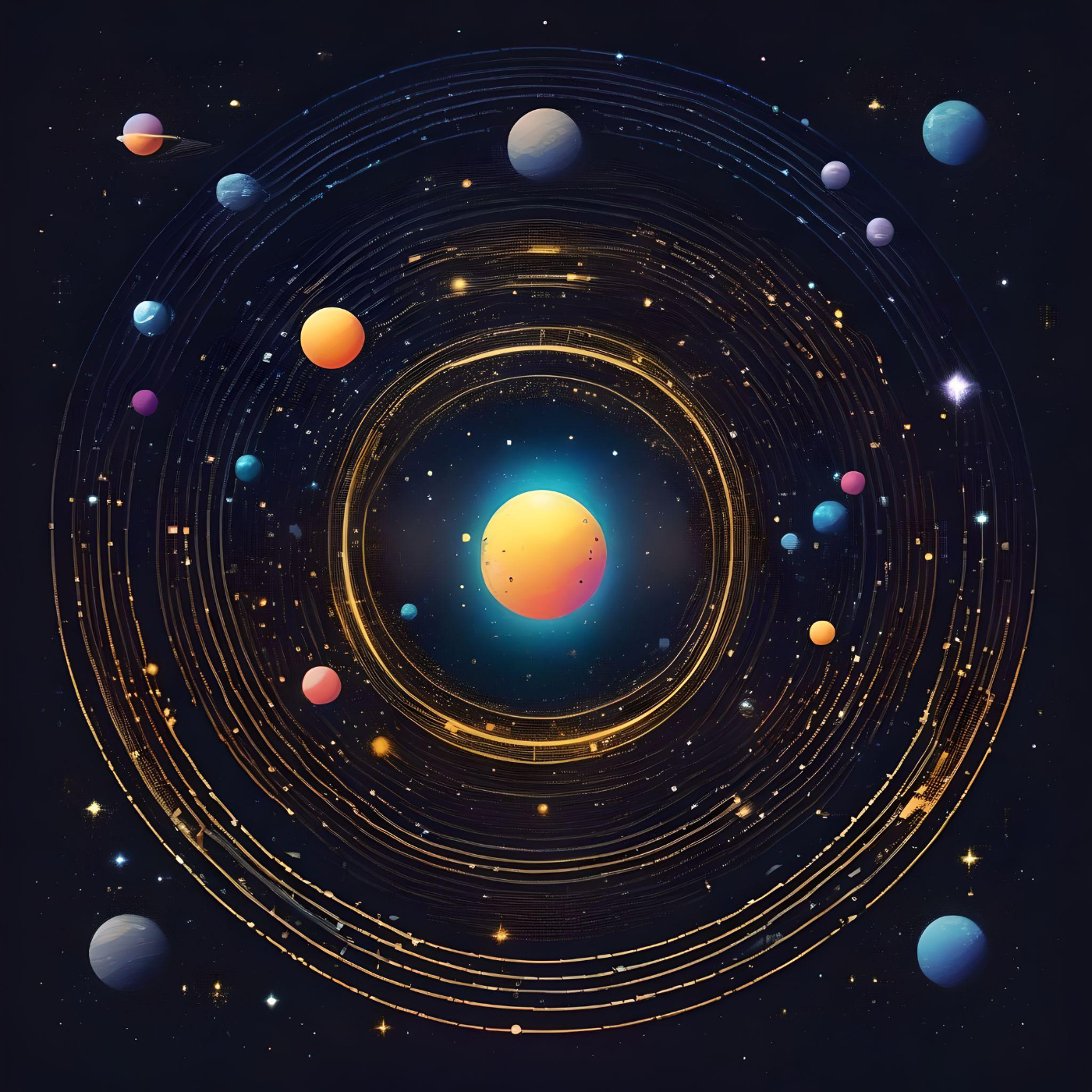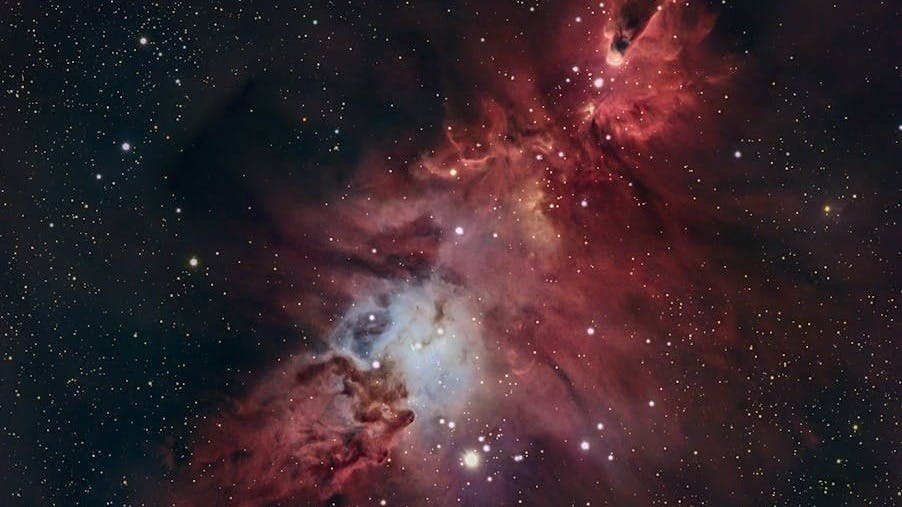Table of Links
3. SkyCURTAINs Method and 3.1 CurtainsF4F
5. Conclusion, Acknowledgments, Data Availability, and References
APPENDIX A: CurtainsF4F TRAINING AND HYPERPARAMETER TUNING DETAILS
A1. CurtainsF4F features preprocessing
5 CONCLUSION
In this work, we described the SkyCURTAINs method, a modelagnostic, template based, data-driven approach to detecting stellar streams in the Milky Way using the Gaia DR2 data. Originally developed for anomaly detection in High Energy Physics, SkyCURTAINs joins the ranks of Via Machinae and CWoLa, in the search for stellar streams, which highlights the versatility of these tools in their performance across different domains. Synergies between the High Energy Physics, Astrophysics, and other communities should be further encouraged in order to identify similar problems that can be solved using the same tools developed in respective fields.
We demonstrated the performance of SkyCURTAINs on the GD-1 stream, and its ability to identify the line-like overdensity in the 𝜙-𝜆 space that corresponds to the GD-1 stream with a very high purity across most patches. The main advantage of SkyCURTAINs is the minimal assumptions it makes about the underlying signal, thereby making it a versatile tool for identifying any localized overdensities (streams, globular clusters, dwarf galaxies) in the feature space of the stars in a model agnostic manner. In this work we chose GD-1 stream, as it provides a good test case for SkyCURTAINs, and is a well known stream in the Milky Way, where we show that SkyCURTAINs currently outperforms the other weakly supervised machine learning methods like Via Machinae and CWoLa in terms of purity by over 10%. For a full sky scan for streams, where the locations of the streams are unknown, the method will need to scan a larger number of 𝜇𝜆. In this case, training two conditional generative models for each patch may not be feasible. However, the modularity of the design of CurtainsF4F step allows for much easier scaling. The base flow can be trained on the entire patch and frozen and then individual top flows can be trained on respective regions of interest, for efficient scaling. SkyCURTAINs builds the template by leveraging the correlations of features with the proper motions, which results in a more background representative template. This allows the method to use more discriminatory features to be used in the downstream
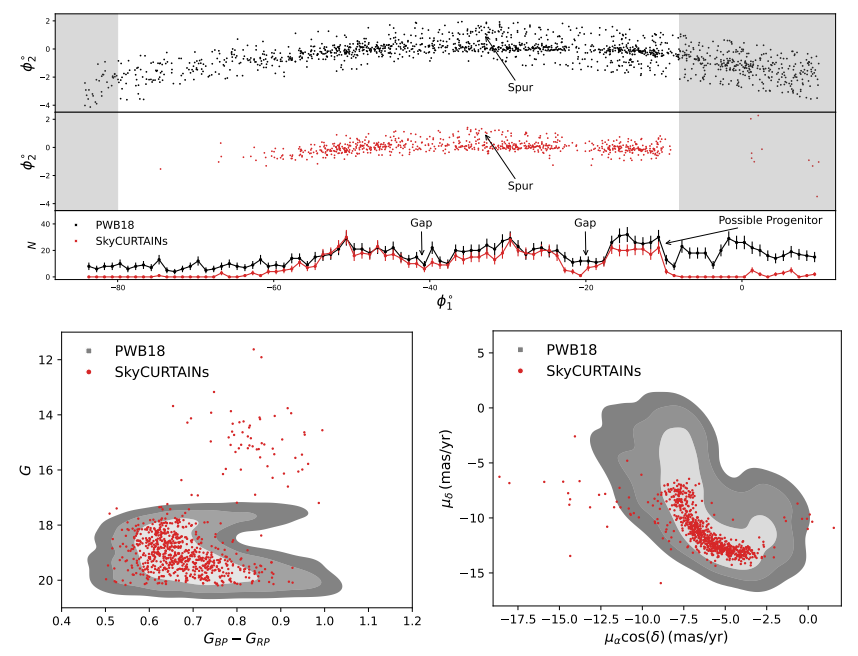
task regardless of their correlation with the proper motions, which otherwise would lead to a biased classifier and thus false positives.
The follow-up work will involve applying SkyCURTAINs in a full sky search for stellar streams in the Milky Way, and comparing the performance of the method with other existing methods. The latest data release GDR3 from Gaia contains over 1.8 billion sources with improved astrometric and photometric measurements for a significantly larger number of sources compared to GDR2, which will provide a more detailed view of the Milky Way. The improved measurements of radial velocities of sources in GDR3 will also allow for a more detailed study of the kinematics of the streams. The improvements in data quality in GDR3 would likely further improve the performance of SkyCURTAINs and as such is a natural next step for the method.
ACKNOWLEDGEMENTS
We would like to acknowledge funding through the SNSF Sinergia grant CRSII5_193716 “Robust Deep Density Models for High-Energy Particle Physics and Solar Flare Analysis (RODEM)”. This work has made use of data from the European Space Agency (ESA) mission Gaia (https://www.cosmos.esa.int/ gaia), processed by the Gaia Data Processing and Analysis Consortium (DPAC, https://www.cosmos.esa.int/web/gaia/dpac/ consortium). Funding for the DPAC has been provided by national institutions, in particular the institutions participating in the Gaia Multilateral Agreement. The computations were performed at University of Geneva using Baobab HPC service. Special thanks to Samuel Klein and Kinga Anna Wozniak for their inputs during the development of the method and this manuscript.
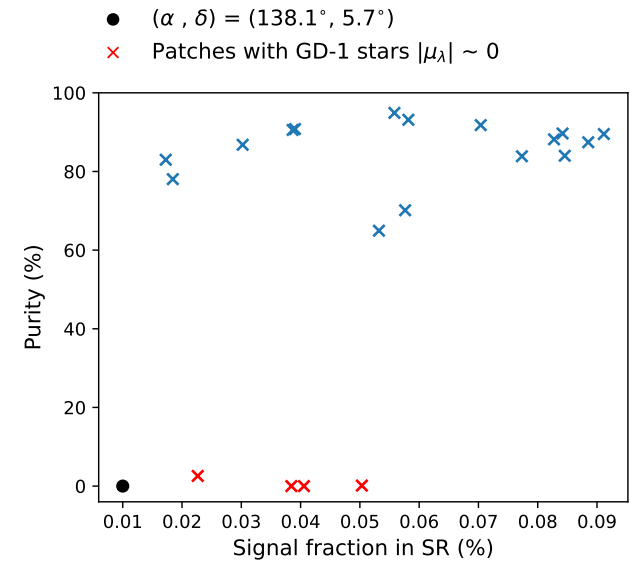

DATA AVAILABILITY
SkyCURTAINs uses the publicly available GDR2 data. A curated set of 21 patches used in this work is available at https://zenodo.org/records/7897936. The GD-1 stream membership labels are taken from https://zenodo.org/records/1295543.
REFERENCES
Banik N., Bovy J., 2019, Monthly Notices of the Royal Astronomical Society, 484, 2009
Belokurov V., et al., 2006, The Astrophysical Journal, 642, L137–L140
Bonaca A., Hogg D. W., Price-Whelan A. M., Conroy C., 2019, The Astrophysical Journal, 880, 38
Bonaca A., et al., 2020, The Astrophysical Journal Letters, 892, L37
Borsato N. W., Martell S. L., Simpson J. D., 2019, Monthly Notices of the Royal Astronomical Society, 492, 1370–1384
Carlberg R. G., 2017, The Astrophysical Journal, 838, 39
Carlberg R. G., Grillmair C. J., Hetherington N., 2012, The Astrophysical Journal, 760, 75
Gaia Collaboration et al., 2018, A&A, 616, A1
Golling T., Klein S., Mastandrea R., Nachman B., Raine J. A., 2023, Phys. Rev. D, 108, 096018
Grillmair C. J., Dionatos O., 2006, The Astrophysical Journal, 643, L17
Helmi A., White S. D. M., 1999, Monthly Notices of the Royal Astronomical Society, 307, 495
Hough P. V., 1962, Method and means for recognizing complex patterns
Ibata R., Lewis G. F., Irwin M., Totten E., Quinn T., 2001, The Astrophysical Journal, 551, 294–311
Ibata R., et al., 2021, The Astrophysical Journal, 914, 123
Johnston K. V., 1998, The Astrophysical Journal, 495, 297–308
Johnston K. V., Zhao H., Spergel D. N., Hernquist L., 1999, The Astrophysical Journal, 512, L109–L112
Koposov S. E., Rix H.-W., Hogg D. W., 2010, The Astrophysical Journal, 712, 260–273
Malhan K., Ibata R. A., 2018, Monthly Notices of the Royal Astronomical Society, 477, 4063–4076
Malhan K., Ibata R. A., Goldman B., Martin N. F., Magnier E., Chambers K., 2018, Monthly Notices of the Royal Astronomical Society, 478, 3862–3870
Meingast, Stefan Alves, João 2019, A&A, 621, L3
Meingast, Stefan Alves, João Fürnkranz, Verena 2019, A&A, 622, L13
Metodiev E. M., Nachman B., Thaler J., 2017,Journal of High Energy Physics, 2017
Nachman B., Shih D., 2020, Physical Review D, 101
Necib L., Lisanti M., Garrison-Kimmel S., Wetzel A., Sanderson R., Hopkins P. F., Faucher-Giguère C.-A., Kereš D., 2019, The Astrophysical Journal, 883, 27
Papamakarios G., Nalisnick E., Rezende D. J., Mohamed S., Lakshminarayanan B., 2021, Journal of Machine Learning Research, 22, 1
Pettee M., Thanvantri S., Nachman B., Shih D., Buckley M. R., Collins J. H., 2023, Weakly-Supervised Anomaly Detection in the Milky Way (arXiv:2305.03761)
Price-Whelan A. M., Bonaca A., 2018, The Astrophysical Journal Letters, 863, L20
Purcell C. W., Zentner A. R., Wang M.-Y., 2012, Journal of Cosmology and Astroparticle Physics, 2012, 027–027
Raine J. A., Klein S., Sengupta D., Golling T., 2023, Frontiers in Big Data, 6
Sanders J. L., Binney J., 2013, Monthly Notices of the Royal Astronomical Society, 433, 1813
Sanders J. L., Bovy J., Erkal D., 2016, Monthly Notices of the Royal Astronomical Society, 457, 3817–3835
Sengupta D., Klein S., Raine J. A., Golling T., 2023, CURTAINs Flows For Flows: Constructing Unobserved Regions with Maximum Likelihood Estimation (arXiv:2305.04646)
Shih D., Buckley M. R., Necib L., Tamanas J., 2021, Monthly Notices of the Royal Astronomical Society, 509, 5992
Shih D., Buckley M. R., Necib L., 2023, Via Machinae 2.0: Full-Sky, ModelAgnostic Search for Stellar Streams in Gaia DR2 (arXiv:2303.01529)
Varghese A., Ibata R., Lewis G. F., 2011, Monthly Notices of the Royal Astronomical Society, 417, 198–215
Vera-Casanova A., et al., 2022, Monthly Notices of the Royal Astronomical Society, 514, 4898
Yuan Z., Chang J., Banerjee P., Han J., Kang X., Smith M. C., 2018, The Astrophysical Journal, 863, 26
A1 CurtainsF4F features preprocessing
The first step in training the CurtainsF4F model is to define the SR and SB regions in 𝜇𝜆. In this work, we chose the SR in a given patch to ensure that the GD-1 stream is fully contained. The SB region, defined as the region adjacent to the SR is chosen to be ∼ 6 mas/yr wide. This ensures sufficient training statistics for the base and the top flow model. The features used for training the CurtainsF4F model are: [𝜙, 𝜆, 𝐺, 𝐺BP − 𝐺RP, 𝜇 ∗ 𝜙 ] and the conditional feature is 𝜇𝜆. As these features have different dynamic ranges, we opt to further scale them to ensure a stable model training. All features are first scaled to be in the range [0, 1]. The 𝐺 feature has a sharp cutoff at 20.2 which proves to be a difficult feature for generative models to learn. To mitigate this, we apply a logit transformation to the 𝐺 feature. The logit transformation is defined as:

Finally, all features are scaled to be in the range [−3, 3].
The data for the base and top flow training is divided into training and validation sets in a 80 : 20 ratio.
A2 Hyperparameter tuning
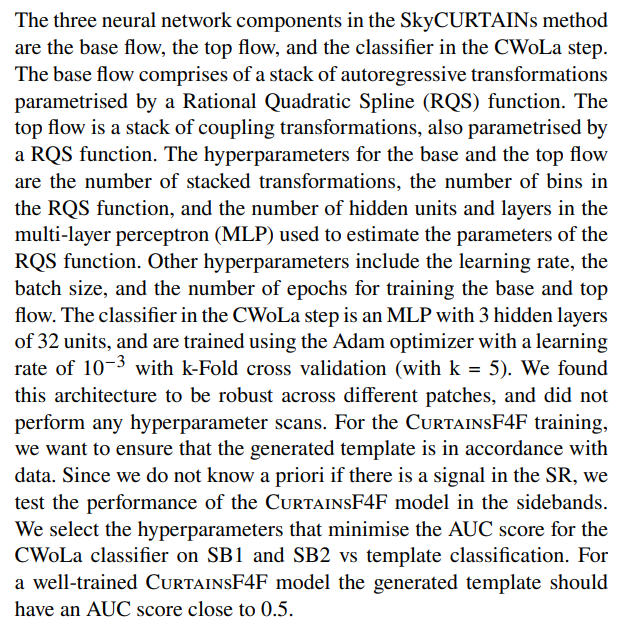
The hyperparameters for the base and top flow are listed in Table A1, where the hyperparameters for the base flows were found to give robust performance regardless of the patch, and so held constant. For the top flows, there could be significant variation in performance related to the hyperparameter selection depending on the patch, and so hyperparameter tuning was performed to find the values that performed well regardless of the patch. Both base and top flow were capped at a maximum number of 150, and 100 epochs respectively. While the base flow seemed to improve with higher number of epochs, the top flow converged much more quickly at ∼ 30 − 40 epochs of training.
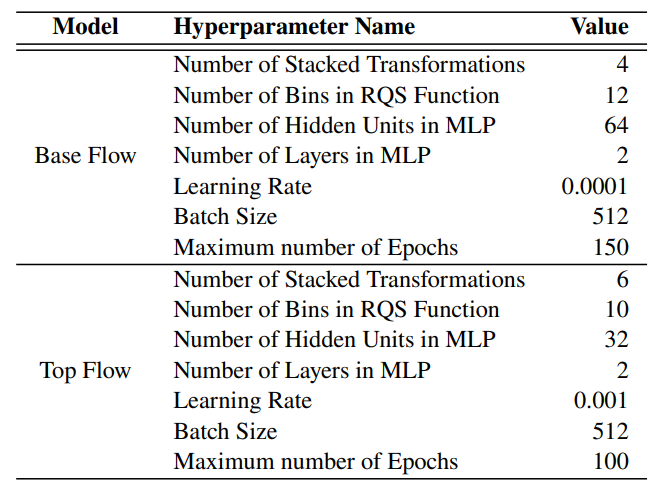
Authors:
(1) Debajyoti Sengupta, Département de physique nucléaire et corpusculaire, University of Geneva, Switzerland ([email protected]);
(2) Stephen Mulligan, Département de physique nucléaire et corpusculaire, University of Geneva, Switzerland;
(3) David Shih, NHETC, Dept. of Physics and Astronomy, Rutgers, Piscataway, NJ 08854, USA;
(4) John Andrew Raine,, Département de physique nucléaire et corpusculaire, University of Geneva, Switzerland;
(5) Tobias Golling, Département de physique nucléaire et corpusculaire, University of Geneva, Switzerland.
This paper is
